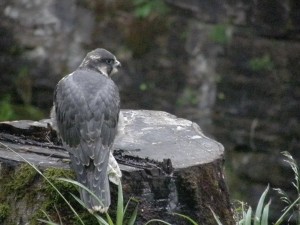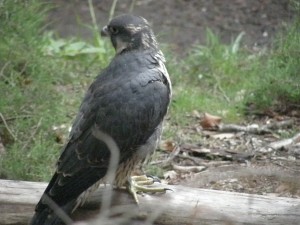Close Encounter
To my delight, one of the juveniles decided that it would feed on a stump just in front of the peregrine site this evening. This gave us amazing views of this individual. It was good to be re united with this youngster (it has a light forehead) after holding it during the ringing 3 weeks ago. At that time is was white and fluffy and quite unrecognisable to how it looks now.

The adults have their feeding areas on the other side of the gorge in the oak tree. They know these areas are well hidden from possible meat thieves (corvids, gulls, other raptors) and undisturbed from people. The eyasses do not have a set ‘table’. When flying around this one must have seen the stump and thought it looked a good place to enjoy the young starling, given to it by it’s father. It was quiet at the site, which was probably a factor.
The youngsters continue to defy their inexperience in the air with expert landings and manoeuvres in the air. They were smart enough to find sheltered spots on the cliff face this morning to avoid the rain.

Our fledgling peregrines seem to be in stark contrast to the young tiercel on BBC’s Springwatch which has had to be rescued a couple of times! As well as the reasons for our fast developing falcons, that I mentioned yesterday (namely the amount our eyasses have been fed and the experience/strength of the parents), young males also usually fledge earlier than falcons. Due to their quicker rate of development, sometimes young males can be over ambitious and try to leave the eyrie before they are truly ready. This may help explain why the two tiercels raised here last year had a bit more of an uneasy start to life in the air! Falcons can often be more cautious and some, particularly those bright (in the head) and strong individuals, will not attempt to fly until they are sure they can!
The mother was behaving rather strangely today. She flew to the 2008 nesting ledge and seemed to be going to eat grit (helps to digest all those bones and feet she eats!), which was normal behaviour. She then however, started to scrape and to sit and turn repeatedly as if making herself comfortable!
This is exactly the behaviour she would go through in March when making a ‘nest’ for her eggs. Maybe she is already planning for next year, despite the fact this years young (who still have along way to go to independence) were calling at her for food! Maybe it is all just getting a bit too much for her and she got confused at what time of year it is!
This was exactly the kind of event I was discussing in a previous post. Despite all the hours I have spent watching peregrines, reading books and scientific journals there are still moments of behaviour I can’t explain and this was one of them. If anyone knows why the Falls of Clyde falcon would seemingly be preparing a nesting ledge in June please let me know!
Peregrines can’t have 2 broods in a year as the young are still reliant on their parents until August. The laying of the eggs and the commitment to her young takes too much out of a falcon (especially and ageing one) by this time of year, for her to raise another family. Re-laying only occurs if eggs are destroyed (weather, predation, people) early on in the year.
With the deafening noise these 2 young falcons are making and their insatiable appetite, I wouldn’t blame this pair from retiring from breeding after this season!
Tom Wells – Peregrine Protection Officer
Help protect Scotland’s wildlife
Our work to save Scotland’s wildlife is made possible thanks to the generosity of our members and supporters.
Join today from just £3 a month to help protect the species you love.
Preface
To my delight, one of the juveniles decided that it would feed on a stump just in front of the peregrine site this evening. This gave us amazing views of …
